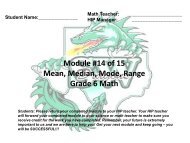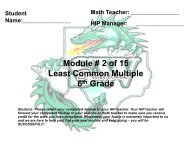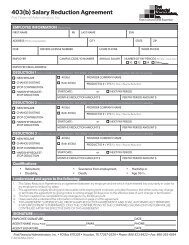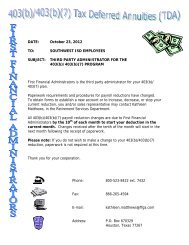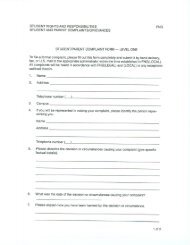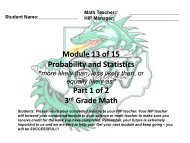Module #11 of 15 Angles Grade 6 Math
Module #11 of 15 Angles Grade 6 Math
Module #11 of 15 Angles Grade 6 Math
Create successful ePaper yourself
Turn your PDF publications into a flip-book with our unique Google optimized e-Paper software.
Student Name:_______________<br />
<strong>Math</strong> Teacher:<br />
HIP Manager:<br />
___________________<br />
___________________<br />
<strong>Module</strong> <strong>#11</strong> <strong>of</strong> <strong>15</strong><br />
<strong>Angles</strong><br />
<strong>Grade</strong> 6 <strong>Math</strong><br />
Students: Please return your completed module to your HIP teacher. Your HIP teacher<br />
will forward your completed module to your science or math teacher to make sure you<br />
receive credit for the work you have completed. Remember, your future is extremely<br />
important to us and we are here to help you! Get your next module and keep going – you<br />
will be SUCCESSFUL!!!
<strong>Math</strong> Dragon Presents<br />
“<strong>Angles</strong>”
ANGLES<br />
There are four types <strong>of</strong> angles you<br />
need to know: acute, right, obtuse,<br />
and straight.
<strong>Angles</strong><br />
Acute <strong>Angles</strong> measure less than 90 .<br />
Right <strong>Angles</strong> measure exactly 90°.<br />
Obtuse <strong>Angles</strong> measure greater than 90° and less than 180°.<br />
Straight <strong>Angles</strong> measure exactly 180°.
<strong>Angles</strong><br />
If you need to know the exact measurement <strong>of</strong> an angle, you need to be<br />
able to read a protractor.<br />
First, find your zero – the<br />
bottom line points to your<br />
zero.<br />
Then, follow the numbers<br />
until you get to the other<br />
line.<br />
Use the outside set <strong>of</strong><br />
numbers because<br />
your zero is on the left.<br />
Notice that from looking at the angle you<br />
should know it is obtuse so expect an<br />
answer greater than 90 and less than 180<br />
This angle measures 120°.
<strong>Angles</strong><br />
Look at another example:<br />
First, find your zero – the<br />
bottom line points to your<br />
zero.<br />
Then, follow the numbers<br />
until you get to the other<br />
line.<br />
Use the inside set <strong>of</strong><br />
numbers because<br />
your zero is on the<br />
right.<br />
Notice that from looking at the angle you<br />
should know it is acute so expect an<br />
answer less than 90 .<br />
This angle measures 50°.
Time to Practice!!!
<strong>Angles</strong><br />
When you look at a picture you should be able to tell<br />
immediately if the angle is acute, right, obtuse or straight.<br />
In quadrilateral KLMN, what type <strong>of</strong> angle is:<br />
K<br />
KNM _______________<br />
70<br />
NKL _______________<br />
N<br />
145<br />
NML _______________<br />
When naming an<br />
angle…read the letters in<br />
order. So angle KNM is<br />
the angle that measures<br />
145 .<br />
M<br />
55<br />
L<br />
obtuse<br />
right<br />
acute
<strong>Angles</strong><br />
Try an example:<br />
First, find your zero – the<br />
bottom line points to your<br />
zero.<br />
Then, follow the numbers<br />
until you get to the other<br />
line.<br />
Use the inside set <strong>of</strong><br />
numbers because<br />
your zero is on the<br />
right.<br />
What kind <strong>of</strong> angle is this? _____________<br />
This angle measures _________<br />
obtuse<br />
140
<strong>Angles</strong><br />
Try another example:<br />
First, find your zero – the<br />
bottom line points to your<br />
zero.<br />
Then, follow the numbers<br />
until you get to the other<br />
line.<br />
Use the outside set <strong>of</strong><br />
numbers because<br />
your zero is on the left.<br />
What kind <strong>of</strong> angle is this? _____________<br />
This angle measures __________<br />
obtuse<br />
100
<strong>Angles</strong><br />
Let’s try a challenging problem:<br />
Notice that neither arrow is<br />
pointing to a zero…so we<br />
need to write down two<br />
numbers and subtract. You<br />
can use either the inside or<br />
the outside set <strong>of</strong> numbers<br />
as long as you use the<br />
same for both.<br />
Be sure to use two<br />
numbers from the<br />
same level: inner or<br />
outer.<br />
What kind <strong>of</strong> angle is this? _____________<br />
This angle measures _________<br />
acute<br />
30
Lets see how much<br />
you have learned!!!
<strong>Angles</strong><br />
Find the measure <strong>of</strong> the following angle:<br />
First, find your zero – the<br />
bottom line points to your<br />
zero.<br />
Then, follow the numbers<br />
until you get to the other<br />
line.<br />
Use the inside set <strong>of</strong><br />
numbers because your<br />
zero is on the right.<br />
What kind <strong>of</strong> angle is this? _____________<br />
This angle measures __________
<strong>Angles</strong><br />
Try a challenging problem:<br />
Be sure to use two<br />
numbers from the<br />
same level: inner or<br />
outer.<br />
What kind <strong>of</strong> angle is this? _____________<br />
This angle measures _________
How will TAKS ask this problem?<br />
The bookshelf attached to Jerome’s wall is shown below.<br />
What type <strong>of</strong> angle is N?<br />
A Acute<br />
B Obtuse<br />
C Right<br />
D Straight
Another TAKS type problem?<br />
What is the measure <strong>of</strong><br />
to the nearest degree?<br />
KMP, formed by the fan shown below,<br />
A 52°<br />
B 48°<br />
C 132°<br />
D 148°<br />
Look for your zero. Then stay on the<br />
same level to find your answer.<br />
Check for reasonableness…should<br />
your answer be acute or obtuse?
Now you will create a<br />
Problem <strong>of</strong> your own!!!
Create Your Own<br />
• You are going to create an angle problem <strong>of</strong><br />
your own.<br />
• You will need to draw a picture and write a<br />
question to go with it for this problem.<br />
• You need to explain what the correct answer is<br />
and WHY?<br />
• Remember what you learned and don’t be afraid<br />
to take a math adventure like our <strong>Math</strong> Dragon!!
Your <strong>Angles</strong> Problem
CONGRATULATIONS!!!<br />
JOB WELL DONE, and we will see you again soon in<br />
“<strong>Math</strong> Dragon’s<br />
<strong>Math</strong> Adventure!!”



